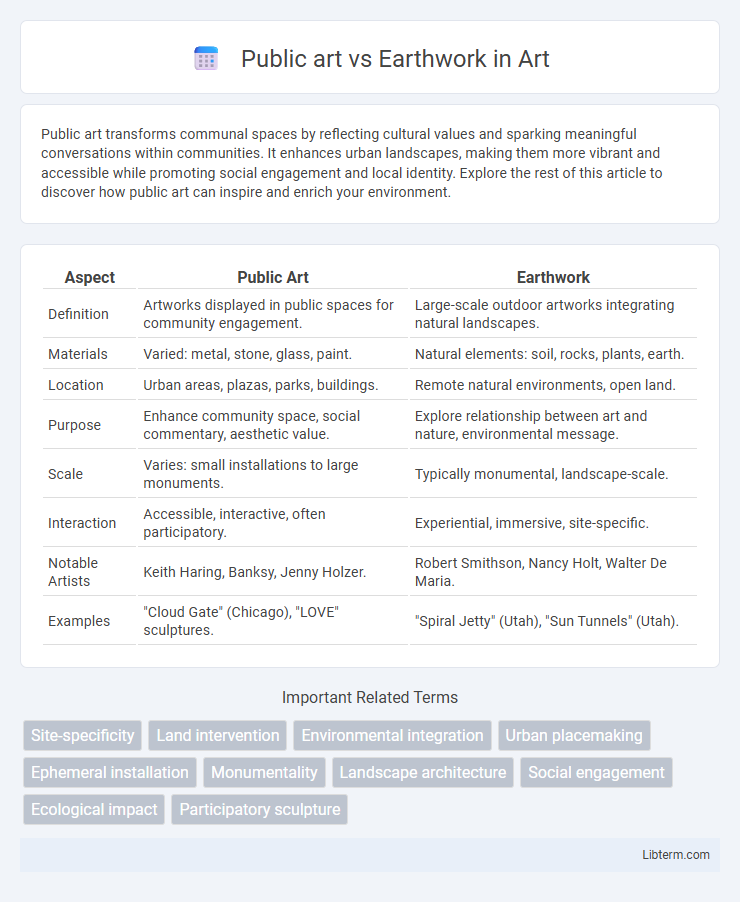Public art transforms communal spaces by reflecting cultural values and sparking meaningful conversations within communities. It enhances urban landscapes, making them more vibrant and accessible while promoting social engagement and local identity. Explore the rest of this article to discover how public art can inspire and enrich your environment.
Table of Comparison
| Aspect | Public Art | Earthwork |
|---|---|---|
| Definition | Artworks displayed in public spaces for community engagement. | Large-scale outdoor artworks integrating natural landscapes. |
| Materials | Varied: metal, stone, glass, paint. | Natural elements: soil, rocks, plants, earth. |
| Location | Urban areas, plazas, parks, buildings. | Remote natural environments, open land. |
| Purpose | Enhance community space, social commentary, aesthetic value. | Explore relationship between art and nature, environmental message. |
| Scale | Varies: small installations to large monuments. | Typically monumental, landscape-scale. |
| Interaction | Accessible, interactive, often participatory. | Experiential, immersive, site-specific. |
| Notable Artists | Keith Haring, Banksy, Jenny Holzer. | Robert Smithson, Nancy Holt, Walter De Maria. |
| Examples | "Cloud Gate" (Chicago), "LOVE" sculptures. | "Spiral Jetty" (Utah), "Sun Tunnels" (Utah). |
Introduction to Public Art and Earthwork
Public art encompasses creative works installed in communal spaces, designed to engage diverse audiences and enhance urban environments through cultural expression. Earthwork, a subset of public art, utilizes natural landscapes and materials to create site-specific installations that emphasize environmental interaction and ecological themes. Both forms challenge traditional gallery settings, prioritizing accessibility and immersive experiences in outdoor contexts.
Defining Public Art: Scope and Intent
Public art encompasses diverse works created for accessible public spaces, aiming to engage communities, enhance cultural identity, and provoke thought. It includes installations, sculptures, murals, and performances designed with intentional interaction between the artwork and the urban or natural environment. Earthwork, as a subset of public art, specifically involves large-scale landscape modifications that emphasize ecological awareness and integrate art with natural terrain.
Understanding Earthwork: Art in the Landscape
Earthwork transforms natural landscapes into large-scale environmental art, emphasizing organic materials and site-specific interventions that engage with ecological processes. Unlike conventional public art, which often occupies urban or communal spaces with constructed installations, Earthwork integrates deeply with the terrain to create immersive experiences that evolve over time. Understanding Earthwork involves recognizing its focus on sustainability, spatial context, and the blending of artistic expression with natural phenomena.
Historical Development of Public Art
Public art's historical development traces back to ancient civilizations where sculptures and murals adorned communal spaces, serving religious, political, and social functions. The 20th century saw a shift towards site-specific earthworks like Robert Smithson's Spiral Jetty, emphasizing environmental interaction and challenging traditional gallery confines. This evolution reflects broader cultural dialogues about space, community engagement, and the relationship between art and nature.
Origins and Evolution of Earthwork
Earthwork art originated in the late 1960s as a response to traditional gallery-based public art, emphasizing large-scale, site-specific interventions that engage directly with natural landscapes. Artists like Robert Smithson and Michael Heizer pioneered this movement by altering earth materials to create monumental works such as "Spiral Jetty" and "Double Negative," shifting the focus from urban environments to remote, natural settings. This evolution marked a departure from conventional public art's architectural and commemorative roles, fostering ecological awareness and challenging the temporality of art by integrating natural processes.
Materials and Techniques: Urban vs. Natural
Public art primarily utilizes durable materials such as metal, concrete, and glass to withstand urban environments, employing techniques like welding, casting, and installation in constructed spaces. Earthwork art integrates natural materials like soil, stone, and plants, relying on landscape modification, sculpting, and ecological processes to blend with natural surroundings. The urban context demands engineered resilience and precision, whereas earthwork embraces organic transformation and temporal change.
Role of Space and Environment
Public art integrates with urban spaces, enhancing cultural identity and social interaction by utilizing plazas, parks, and streetscapes to engage diverse audiences. Earthworks transform natural landscapes into large-scale environmental sculptures, emphasizing site-specificity and ecological processes, often altering terrain or vegetation to create immersive experiences. The role of space in public art is primarily social and accessible, whereas in earthwork it is experiential and ecological, highlighting the interconnectedness between art and the environment.
Audience Interaction and Accessibility
Public art often invites direct audience interaction through easily accessible urban spaces, encouraging community engagement and spontaneous encounters. Earthwork, typically situated in remote natural environments, challenges accessibility but offers immersive experiences that connect viewers with the landscape's scale and ecological context. Both forms redefine audience participation, with public art prioritizing social interaction and earthworks emphasizing environmental awareness.
Preservation and Sustainability Challenges
Public art faces preservation challenges due to exposure to urban pollution, vandalism, and weathering, requiring regular maintenance and protective measures to sustain its aesthetic and cultural value. Earthworks confront sustainability issues as natural erosion, vegetation growth, and climate change can alter or degrade their intended form, demanding careful environmental monitoring and conservation strategies. Both art forms necessitate balancing accessibility with preservation to ensure long-term durability while maintaining their connection to place and community.
Contemporary Examples and Future Trends
Contemporary public art emphasizes interactive installations in urban spaces, engaging diverse audiences through digital technology and augmented reality, as seen in works like TeamLab's immersive exhibits. Earthwork art, exemplified by projects like James Turrell's Roden Crater and Olafur Eliasson's Ice Watch, integrates natural landscapes to explore environmental themes and temporal changes. Future trends indicate a fusion of ecological sustainability and technological innovation, with artists utilizing renewable materials and smart sensors to create dynamic, eco-conscious experiences.
Public art Infographic

 libterm.com
libterm.com